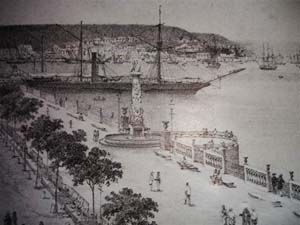5.7 Coliseum. The first Cuban theater building erected in the 18th century.

The Coliseum is the first building erected in Havana and Cuba for the purpose of hosting theatrical performances, making it the first Cuban theater. It opened its doors on January 20, 1775, located across from the Alameda de Paula, which was inaugurated around that time, and between Acosta, Oficios, and Luz streets (where Oficios and Luz streets meet today in Old Havana).
The initiative to create this theater came from the Marquis de la Torre. Seeing the city’s need for a venue with the necessary conditions for this art form, he brought together Havana’s most important merchants and prominent figures on July 2, 1773, to raise funds for the construction of this space. At that meeting, de la Torre stated that the money would be returned to them through the theater’s profits.
Shortly after, construction began under the direction of Havana architect Antonio Fernández Trebejo, leading to the construction of the Havana Coliseum in 1775, a masonry and wood building. It was highly appreciated by all the foreigners who visited it, who described it as magnificent.
The same year this theater opened, on October 12th to be exact, a momentous event took place there that would go down in the history of Cuban theater. An opera was presented on the island for the first time: Didone abbandonata, a work with a libretto by Metastasio and music by an unknown composer.
Performances were held on Sundays, during which a program comprised both Spanish and foreign companies passing through the city, as well as Cuban musicians and actors. Its peak was between 1880 and 1883, according to surviving records from the town.
Thanks to studies conducted on the history of theater in Mexico, we have been able to find some stories about the artists who worked at the Havana Coliseum.
According to studies conducted by specialists, we find that in the late 1770s, the first lady, Antonia de San Martín, worked there. She later joined the Royal Coliseum Company in the capital of what was then New Spain. She was a member of the Havana company and a prominent actress of the time, and her performances were huge box-office hits in 18th-century Cuba.
Later in 1785, a family of Italian dancers (Gerolamo Marani and Teresa Pier Antoni with their four children) arrived in the country and are believed to have performed at the Coliseum for a year. Marani, or Geronimo, as he was known in America, was a choreographer and principal dancer; along with his wife and two of his children, he performed at this Cuban theater from 1785 until 1786, when he left for Mexico.
In 1788, it was in poor condition and, by order of the Havana City Council, was closed for the first time. It was then repaired and expanded, and its interior was completely made of wood. Already in the 1990s, newspaper reviews appeared that referenced the Coliseum. An example of this is the first issue of the Havana Newspaper from 1790, which featured a chronicle of a Spanish troupe that regularly performed there.
In November of the following year, the zarzuela, El alcalde de Mairena, by Joseph Fallótico, was staged; this was the first performance of a zarzuela in the Cuban archipelago.
Thirteen years after its inauguration, the Coliseum was closed due to its decay. It underwent renovations and reopened in 1803 under the name El Principal. It is said to have been superior in terms of luxury and conditions to theaters in the United States. It hosted a vibrant theatrical life until it was devastated by a cyclone in 1846.
Also joining this list of artists were sisters Josefa and Bárbara González, figures known as the “Habaneras,” who left for Mexico after the Coliseum closed for the first time. Fernando Gavila, a Spaniard, was a leading actor and playwright who worked in this Cuban theater at the end of the 18th century as part of the Havana company. He is considered one of the first leading figures of Havana theater.
Numerous works of various genres and artists were presented, including tragedies, comedies, short operas, dancers, acrobats, shadow puppets, automatons, interludes, and ditties.
The Coliseum, one of the great contributions made to Havana by Captain General Marqués de la Torre, became one of the most important theatrical spaces in 18th-century Havana.








